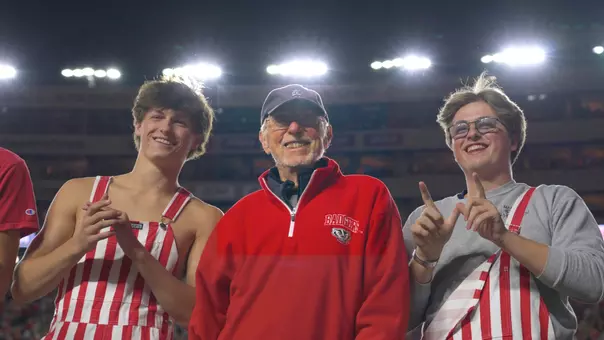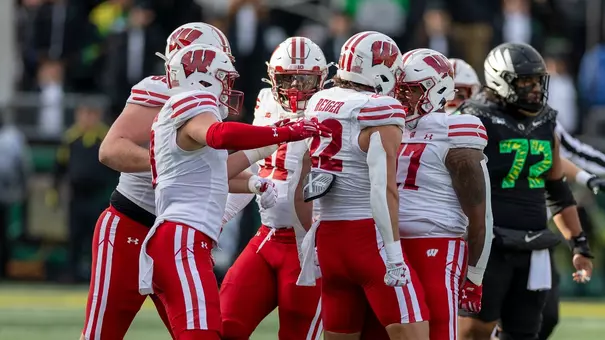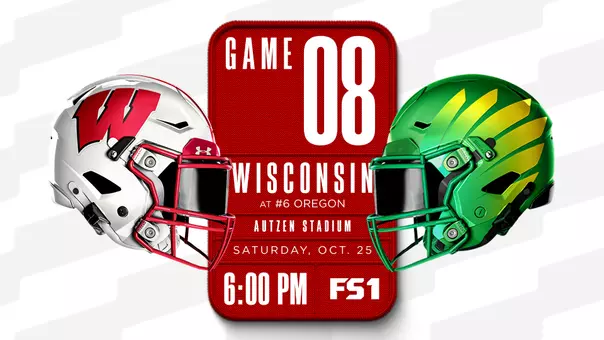
NCAA’s all-time leading rusher is matter of right and wrong
September 10, 2024 | Football, Andy Baggot
While the numbers say Dayne is king, NCAA says otherwise
BY ANDY BAGGOT
UWBadgers.com Insider
They are two moments of joy and achievement that Jeff Horton will never forget from his 45 years in college football.
On Nov. 13, 1999, Horton was the quarterbacks coach at Wisconsin when tailback Ron Dayne became the all-time leading rusher in Football Bowl Subdivision history.
"Such a special, special moment," Horton said.
On Dec. 17, 2016, Horton was the associate head coach, offensive coordinator and running backs coach at San Diego State when Donnel Pumphrey became the all-time leading rusher in FBS history.
"I wouldn't trade either (memory) for anything," Horton said.
That's understandable given Horton's experiences with the two senior NFL-bound running backs. His first season with the Badgers came in '99 when Dayne won the Heisman Trophy and helped lead UW to its second consecutive Big Ten Conference title and Rose Bowl victory. Meanwhile, Horton not only recruited Pumphrey out of Canyon Springs High School in Las Vegas, he watched as Pumphrey and teammate Rashaad Penny became the first FBS running backs to rush for 2,000 yards and 1,000 yards in the same season, respectively.
But there's a catch and Horton is well aware of it.
Dayne finished his 43-game college career with 7,125 rushing yards, while Pumphrey completed his 54-game career with 6,405 yards. Both totals include performances in bowl games, so the question begs: How did this flawed equation come to life?
Well, until 2002, the NCAA didn't include postseason statistics such as bowl games in its career totals. When it finally did 23 years ago, its membership – especially sports information directors – elected not to retroactively add stats from previous seasons.
Thus, Pumphrey is seen as record-holder followed by Dayne (6,397), Ricky Williams of Texas (6,279), former UW running back Jonathan Taylor (6,174) and Tony Dorsett of Pittsburgh (6,077).
Well before Chris McIntosh became the Wisconsin athletic director in 2021, he was a senior left tackle and co-captain for the Badgers from 1996 to 1999. It bugs him mightily that Dayne isn't seen as the No. 1 rusher in FBS history.
"It's upsetting on multiple levels," he said. "Personally, obviously as someone who was part of those teams, of those four years with Ron – even more personally as someone who blocked for him – I don't understand it. I don't understand how the goalposts are allowed to shift when the actual data – the actual results of those games are available."
Dayne's current NCAA resume is missing four bowl games that total 728 yards – 246 yards in the '96 Copper Bowl, 36 yards in the '97 Outback Bowl, 246 in the '98 Rose Bowl and 200 in the '99 Rose Bowl – and ended with him being named Most Valuable Player three times.
"I've not heard a convincing argument why Ron Dayne should not be considered the all-time NCAA rushing leader," McIntosh said. "Maybe there's an argument out there, but it's not one that I've heard. Until then, in my mind, personally and on behalf of our program, Ron Dayne is the all-time NCAA rushing leader."
On this, the 25th anniversary of Dayne's extraordinary season, who better than a coach who's able to compare the two NFL-bound running backs to weigh in.
"Two different guys, but a lot of the same characteristics," Horton said. "The want-to, the attitude, the striving to be great."
Both played four years and wound up in the NFL – Dayne was chosen in the first round by the New York Giants in 2000, while Pumphrey was drafted by Philadelphia in the fourth round that same year – but their similarities end there.
While Dayne was listed at 5-foot-10 and 250 pounds and was a Parade All-American, Pumphrey was 5-8 and 150 pounds "maybe 155 if he had a rock in his pocket," according to Horton, who said Nevada-Reno and UNLV were the only other schools vying for Pumphrey's services.
"The tape didn't lie, but in high school he was probably 140 pounds," Horton said of Pumphrey. "He was a special, special talent. He played like he weighed 220 and was just explosive and dynamic and he had that chip on his shoulder because he was too small. He played angry."
As for Dayne, "Ronnie was so smooth," Horton said. "He was a big guy, but it was like he weighed 150 pounds with his feet. So smooth and effortless. Some of his greatest runs to me weren't the big ones. They were when it was like he should have had a minus-2 or 3-yard play and, somehow, he'd make 10 or 12 even though everyone knew he was getting the ball."
Horton said the scene at Camp Randall 25 seasons ago was unforgettable. Dayne needed 99 rushing yards against last-place Iowa to surpass Williams and the Badgers needed a victory to clinch their second straight Big Ten title and secure another Rose Bowl berth.
Dayne became the all-time leading rusher courtesy of a 31-yard run in the second quarter, finishing with 216 yards, while UW rolled to a 41-3 decision.
"You could feel the energy building as the game went along," Horton said. "It was just incredible to be there."
Horton had a different role as play-caller for the Aztecs 17 years later. Going into a Las Vegas Bowl duel with Houston, he not only had to call plays in an effort to get Pumphrey to top Dayne, he needed to get Penny a shot at 1,000 yards.
"I've never felt that much pressure in a game to get that done," Horton said.
Pumphrey, who declined to be interviewed, had seven carries for minus-1 yard and SDS trailed 10-0 after one quarter. But he finished with 115 yards on 19 carries, surpassing Dayne on a 15-yard run in the fourth quarter.
"The whole crowd erupted," Horton said.
As for the real FBS record-holder for most rushing yards, Horton demurred.
"We don't make the rules," he said. "We abide by them.
"Both are championship runners. Both were lifetime memories."
McIntosh was more direct.
"As we come up on 25 years, it gives us an opportunity to revisit the history and the accomplishment that (Dayne) had. It also allows us to have some discussion about what's right.
"I think the first place to start on the issue is right and wrong and then figure out what to do with it. I think it's wrong that the history has been rewritten. That's not to diminish anyone else's accomplishments or achievements, but I don't think anything should be allowed to get in the way of right or wrong."
UWBadgers.com Insider
They are two moments of joy and achievement that Jeff Horton will never forget from his 45 years in college football.
On Nov. 13, 1999, Horton was the quarterbacks coach at Wisconsin when tailback Ron Dayne became the all-time leading rusher in Football Bowl Subdivision history.
"Such a special, special moment," Horton said.
On Dec. 17, 2016, Horton was the associate head coach, offensive coordinator and running backs coach at San Diego State when Donnel Pumphrey became the all-time leading rusher in FBS history.
"I wouldn't trade either (memory) for anything," Horton said.
That's understandable given Horton's experiences with the two senior NFL-bound running backs. His first season with the Badgers came in '99 when Dayne won the Heisman Trophy and helped lead UW to its second consecutive Big Ten Conference title and Rose Bowl victory. Meanwhile, Horton not only recruited Pumphrey out of Canyon Springs High School in Las Vegas, he watched as Pumphrey and teammate Rashaad Penny became the first FBS running backs to rush for 2,000 yards and 1,000 yards in the same season, respectively.
But there's a catch and Horton is well aware of it.
Dayne finished his 43-game college career with 7,125 rushing yards, while Pumphrey completed his 54-game career with 6,405 yards. Both totals include performances in bowl games, so the question begs: How did this flawed equation come to life?
Well, until 2002, the NCAA didn't include postseason statistics such as bowl games in its career totals. When it finally did 23 years ago, its membership – especially sports information directors – elected not to retroactively add stats from previous seasons.
Thus, Pumphrey is seen as record-holder followed by Dayne (6,397), Ricky Williams of Texas (6,279), former UW running back Jonathan Taylor (6,174) and Tony Dorsett of Pittsburgh (6,077).
Well before Chris McIntosh became the Wisconsin athletic director in 2021, he was a senior left tackle and co-captain for the Badgers from 1996 to 1999. It bugs him mightily that Dayne isn't seen as the No. 1 rusher in FBS history.
"It's upsetting on multiple levels," he said. "Personally, obviously as someone who was part of those teams, of those four years with Ron – even more personally as someone who blocked for him – I don't understand it. I don't understand how the goalposts are allowed to shift when the actual data – the actual results of those games are available."
Dayne's current NCAA resume is missing four bowl games that total 728 yards – 246 yards in the '96 Copper Bowl, 36 yards in the '97 Outback Bowl, 246 in the '98 Rose Bowl and 200 in the '99 Rose Bowl – and ended with him being named Most Valuable Player three times.
"I've not heard a convincing argument why Ron Dayne should not be considered the all-time NCAA rushing leader," McIntosh said. "Maybe there's an argument out there, but it's not one that I've heard. Until then, in my mind, personally and on behalf of our program, Ron Dayne is the all-time NCAA rushing leader."
On this, the 25th anniversary of Dayne's extraordinary season, who better than a coach who's able to compare the two NFL-bound running backs to weigh in.
"Two different guys, but a lot of the same characteristics," Horton said. "The want-to, the attitude, the striving to be great."
Both played four years and wound up in the NFL – Dayne was chosen in the first round by the New York Giants in 2000, while Pumphrey was drafted by Philadelphia in the fourth round that same year – but their similarities end there.
While Dayne was listed at 5-foot-10 and 250 pounds and was a Parade All-American, Pumphrey was 5-8 and 150 pounds "maybe 155 if he had a rock in his pocket," according to Horton, who said Nevada-Reno and UNLV were the only other schools vying for Pumphrey's services.
"The tape didn't lie, but in high school he was probably 140 pounds," Horton said of Pumphrey. "He was a special, special talent. He played like he weighed 220 and was just explosive and dynamic and he had that chip on his shoulder because he was too small. He played angry."
As for Dayne, "Ronnie was so smooth," Horton said. "He was a big guy, but it was like he weighed 150 pounds with his feet. So smooth and effortless. Some of his greatest runs to me weren't the big ones. They were when it was like he should have had a minus-2 or 3-yard play and, somehow, he'd make 10 or 12 even though everyone knew he was getting the ball."
Horton said the scene at Camp Randall 25 seasons ago was unforgettable. Dayne needed 99 rushing yards against last-place Iowa to surpass Williams and the Badgers needed a victory to clinch their second straight Big Ten title and secure another Rose Bowl berth.
Dayne became the all-time leading rusher courtesy of a 31-yard run in the second quarter, finishing with 216 yards, while UW rolled to a 41-3 decision.
"You could feel the energy building as the game went along," Horton said. "It was just incredible to be there."
Horton had a different role as play-caller for the Aztecs 17 years later. Going into a Las Vegas Bowl duel with Houston, he not only had to call plays in an effort to get Pumphrey to top Dayne, he needed to get Penny a shot at 1,000 yards.
"I've never felt that much pressure in a game to get that done," Horton said.
Pumphrey, who declined to be interviewed, had seven carries for minus-1 yard and SDS trailed 10-0 after one quarter. But he finished with 115 yards on 19 carries, surpassing Dayne on a 15-yard run in the fourth quarter.
"The whole crowd erupted," Horton said.
As for the real FBS record-holder for most rushing yards, Horton demurred.
"We don't make the rules," he said. "We abide by them.
"Both are championship runners. Both were lifetime memories."
McIntosh was more direct.
"As we come up on 25 years, it gives us an opportunity to revisit the history and the accomplishment that (Dayne) had. It also allows us to have some discussion about what's right.
"I think the first place to start on the issue is right and wrong and then figure out what to do with it. I think it's wrong that the history has been rewritten. That's not to diminish anyone else's accomplishments or achievements, but I don't think anything should be allowed to get in the way of right or wrong."
Luke Fickell Post-Game Media Conference || Wisconsin Football vs Ohio State || Oct. 18, 2025
Saturday, October 18
Luke Fickell Post-Game Media Conference || Wisconsin Football vs Iowa || Oct. 11, 2025
Saturday, October 11
Luke Fickell Weekly Press Conference || Wisconsin Football || Oct. 6, 2025
Monday, October 06
Luke Fickell Post-Game Media Conference || Wisconsin Football at Michigan || Oct. 4, 2025
Saturday, October 04













